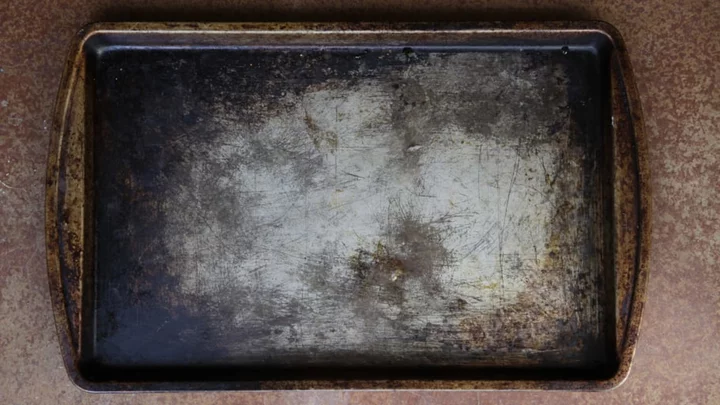Baking sheets are workhorses in the kitchen. The same simple pan you use to roast chicken, fish, and vegetables can bake foccacia, cake, and pizza just as easily. While cooking with one is a no-brainer, keeping your baking sheet sparkling clean between uses is more complicated. To determine the best cleaning methods and products for the job, we spoke to a professional chef.
As the lead recreational chef-instructor for the Institute of Culinary Education, Roger Sitrin knows better than most people how much work goes into maintaining baking pans. When tackling baked-on bits, he resorts to a tactic many home cooks are guilty of: the overnight soak.
“Let’s say I baked on it and it’s a sugar mess," he tells Mental Floss. “The easiest way I do it is I leave it in the sink, let water sit on it, and let that melt off.” So if your housemates complain about the pans you left soaking in the sink, tell them you’re following a professional’s advice.
Once the food matter has had a chance to soften, Sitrin attacks it with a deep scrub. A sponge with soap and warm water may be sufficient, but in tougher cases he recommends steel wool with an abrasive cleaner. Bar Keeper’s Friend ($7) is his go-to product. “Bar Keeper’s Friend will get grease off [and] will get sugar off,” he says.
The powder contains oxalic acid, a natural compound that breaks down stubborn stains at the molecular level. The same ingredient that makes it an effective cleanser also makes it uncomfortable to handle. To protect your skin, you should always wear gloves when cleaning with the product. If that sounds too intense for your needs, Sitrin suggests a gentler alternative.
“I just found this new product that people have been talking about called The Pink Stuff. It’s a cleaning paste. It’s like a mild abrasive, multipurpose cleaner, and it gets everything very clean,” he says of the $6 product. “Bar Keeper’s Friend is more of a scouring powder. So the difference, the reason why I like The Pink Stuff, is because sometimes Bar Keeper’s Friend can be a little caustic. The Pink Stuff is baking soda, quartz, sodium silicate, and soap, which is why it’s gentle on your hands.”
Baking soda is naturally alkaline, which makes it great at dissolving food residue in water. If you don’t feel like using commercial cleaning products, you can also make your own baking soda paste at home.
Most of these cleaning methods are fairly aggressive, so it’s important that your baking sheet can stand up to them. Sitrin favors the basic, aluminum, rimmed half sheets ($26) used by restaurants. “The nice thing about these pans you get at the restaurant supply store is that they’re not precious, they’re not coated, they’re not anything you have to worry about giving a nice scrub to.”
Sticking to affordable, heavy duty pans makes it easier to accept scuffs and scorches—which are inevitable if you use your pans often enough, no matter how hard you scrub them. “Do they get a little scratched up? Yes, but that’s OK,” Sitrin says. “I don’t mind it if they get a little patina on them, if they get a little brown and used looking. That’s perfectly fine. The more you use them, the more flavor they have.”
This article was originally published on www.mentalfloss.com as The Best Way to Clean Baking Sheets, According to a Professional Chef.









